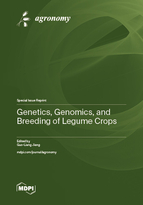Genetics, Genomics, and Breeding of Legume Crops
A special issue of Agronomy (ISSN 2073-4395). This special issue belongs to the section "Crop Breeding and Genetics".
Deadline for manuscript submissions: closed (30 June 2020) | Viewed by 61753
Special Issue Editor
Interests: plant cultivar development; germplasm enhancement; breeding principles and methodologies; QTL analysis and molecular marker applications; genome-wide association study (GWAS); genetic analysis and characterization of traits; gene exploiting/discovery; trait integration
Special Issue Information
Dear Colleagues,
Legume crops are grown around the world, primarily for their grain seeds, which are widely used for human and animal consumption or for the production of oils for industrial uses, with some species grown for vegetables or livestock forage. Broadly, legumes include well-known crops such as soybean, common bean or dry bean, peanut, peas, chickpeas, cowpea, lentils, alfalfa, clover, etc. Another distinctive nature of legume crops is the nitrogen-fixing function. Most legume crops have symbiotic nitrogen-fixing bacteria in structures called root nodules. From a nutritional standpoint, legume crops are a significant source of protein, oil, dietary fiber, carbohydrates and dietary minerals. Economically, they also play an important role in international trade. Genetic improvements have been a key to the growth of crop production and will continuously contribute to sustainable agriculture and food security. Presently, plant genetic improvements are in the middle of an evolution, from field-based traditional breeding to a new era of applications of multiple novel techniques, such as marker-assisted selection, genomic prediction and gene-editing, which will be integrated with conventional methods in practical breeding. Research has involved all the traits of importance, including yield, quality, resistance to pests/diseases and abiotic stresses for the present. This Special Issue will provide a platform to present and discuss related topics of research, progress and trend in genetic, genomics and breeding of legume crops.
Dr. Guo-Liang Jiang
Guest Editor
Manuscript Submission Information
Manuscripts should be submitted online at www.mdpi.com by registering and logging in to this website. Once you are registered, click here to go to the submission form. Manuscripts can be submitted until the deadline. All submissions that pass pre-check are peer-reviewed. Accepted papers will be published continuously in the journal (as soon as accepted) and will be listed together on the special issue website. Research articles, review articles as well as short communications are invited. For planned papers, a title and short abstract (about 100 words) can be sent to the Editorial Office for announcement on this website.
Submitted manuscripts should not have been published previously, nor be under consideration for publication elsewhere (except conference proceedings papers). All manuscripts are thoroughly refereed through a single-blind peer-review process. A guide for authors and other relevant information for submission of manuscripts is available on the Instructions for Authors page. Agronomy is an international peer-reviewed open access monthly journal published by MDPI.
Please visit the Instructions for Authors page before submitting a manuscript. The Article Processing Charge (APC) for publication in this open access journal is 2600 CHF (Swiss Francs). Submitted papers should be well formatted and use good English. Authors may use MDPI's English editing service prior to publication or during author revisions.
Keywords
- Legume crops
- Germplasm
- Genetics
- Genomics
- Breeding
- Marker-assisted selection
- Genomic prediction
- QTL
- GWAS
- Molecular mapping
- trait improvement






